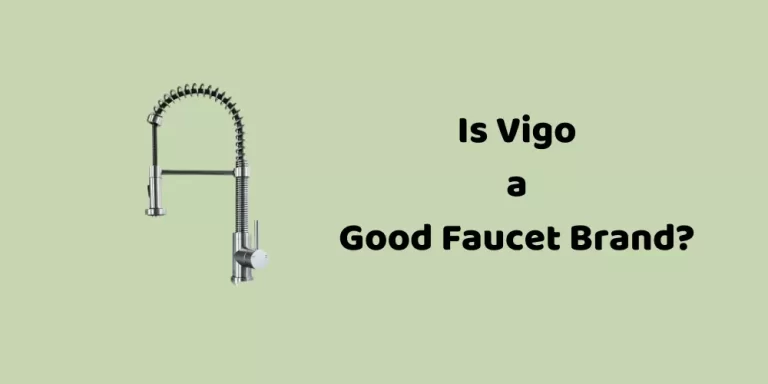Why Does Dripping Faucet Prevent Frozen Pipes?
Frozen pipes are the biggest problem in the winter season in cold places. Water freezes into pipes and with times its pressure increases which result in bursting of pipes and become the reason for flood in the house.
A burst pipe can throw hundreds of gallons of water into the house. Frozen pipes damage the plumbing system of the house. You need to spend money to get it repaired.
If you are leaving in a cold place, you would have faced this situation earlier. People do many things to prevent pipes from freezing. You would have heard about keeping faucets dripping to prevent pipes from freezing.
But why does dripping faucet prevent frozen pipes? Let’s know in this article.

On Sale
Moen Arbor Faucet (The Right Faucet For Freezing Weather)
Spot Resist Stainless finish resists fingerprints and water spots, Power Boost technology offers a faster clean, smooth operation, and easy movement
What Temperature Do I Need To Worry About Pipes Freezing?

We all know pipes freeze in cold weather but what is the threshold point? Leaves begin to fall from trees, and the countdown to the winter season starts.
At 20 degrees Fahrenheit or -6 degrees Celsius, the water starts freezing. When the temperature goes beyond this water molecules get frozen.
Sometimes, you would have noticed that pipes inside the house are not frozen but pipes outside the house are frozen. This happens because the home’s inside temperature is warmer than the outside. Which prevents pipes from freezing.
If possible, try not to expose pipes to freezing temperatures. Try to place them in the heated place, crawl spaces, and vulnerable outside walls. If you are building a new house, you may ask the builder to set up a proper heat system for plumbing.
Why Does Dripping Faucet Prevent Frozen Pipes?

With the icy cold temperature, pipes start getting frozen. Frozen pipes become a nightmare if you can’t unfreeze them quickly.
One of our friends suggests letting faucets drip to prevent pipes from freezing. We did this the last winter and surprisingly, it prevented water from freezing inside the pipe. No frozen water, so no bursting of pipes.
Mostly outside faucets and uninsulated faucets are victims of frozen water. The freezing water problem starts with a drop in the temperature.
You may be thinking, why does a dripping faucet prevent frozen pipes?
Get Instant Solutions For Your Home Issues For Free - Chat With Experts
Get Paid For Your Opinion With Online Surveys - Start Earning
Its answer is simple. Dripping the faucet slows down the process of freezing and keeps the pressure inside the pipe down. Water freezes when its heat is transferred to cold air. If you can keep the faucet in a heated place, its heat won’t transfer into cold air.
But it is not possible. A house has many faucets and keeping them hot is not possible. It will cost a huge bill.
So dripping the faucet is a good solution.
When you let the faucet drip, its water remains in liquid form and flows through the whole pipeline. The temperature inside pipes doesn’t reach freezing point due to flowing water.
The constant flow of water will relieve pressure inside pipes. It won’t create any ice blockage. As the pipe won’t freeze, no burst will occur.
Should You Drip All Faucets?

It is not necessary to drip all faucets to prevent them from freezing. First, check which faucet has a frozen water issue.
Most time, outside faucets get frozen. So, by keeping outside faucets dripping, your problem will be solved. You don’t need to drip the faucet inside the house.
Faucets that are connected to the hot water supply won’t need to let drip. Their water won’t freeze.
Pipelines that are in touch with cold weather directly, will get frozen quickly. If your plumber wouldn’t give attention to this situation, you will face a frozen pipe issue in the winter. Pipes that are installed outside the house are directly connected to cold weather.
So, you should drip the faucet which is the end point of the pipe. A dripping faucet should be as far away from the source of water. It will affect all connected faucets of that pipeline.
Whenever you see the water flow of faucets is down, let them drip so they won’t freeze.
FAQ About Why Does Dripping Faucet Prevent Frozen Pipes
How Fast Should Water Drip To Prevent Pipes From Freezing?
A dripping faucet saves pipes from bursting but at what speed you should let it drip? Pipes material is durable but when frozen water reaches its extreme temperature, pipes burst.
Five to ten drops per minute are enough fast to prevent pipes from freezing.
Dripping faucets is a way to prevent pipes from bursting. Frozen pipes are common things in an older home in the winter.
Do You Need To Drip Faucets In Newer Homes?
It depends on which type of plumbing system you have in the house. If your new home has an insulated plumbing system that pipes from getting cold, you don’t need to let the faucet drip.
Should I Leave the Faucet Open If the Pipes Are Frozen?
Yes, it is a good idea to let the faucet open and drip water drops from it if the pipes are frozen. It will create motion in the pipe which will prevent pipes from freezing. Dripping water from the faucet maintains pressure in the faucet and pipes won’t burst.
Will Pipes Burst If It Is Frozen?
Not every time pipes burst when it is frozen. Frozen pipes are a common problem in the winter. But when the pressure inside pipes goes beyond its level then they burst. So, leave the faucet dripping to prevent pressure from increasing.
Conclusion
A dripping faucet is an important task in the winter, but for those homes that have frozen pipes issues. Dripping faucets is a good idea to deal with frozen pipe situations. Water converts into ice dam into pipes with decreasing in the temperature. With time, these ice dams lead to big cracks, and pipes get busted. So, now you have a clear idea of why does dripping faucet prevent frozen pipes.

Meet Ralph Matthews, father of 2 cute daughters and a skilled plumber with over 10 years of experience in the industry. Ralph has particular expertise in repairing any type of faucet and has helped countless homeowners and businesses solve their plumbing problems with his expert knowledge and attention to detail.






